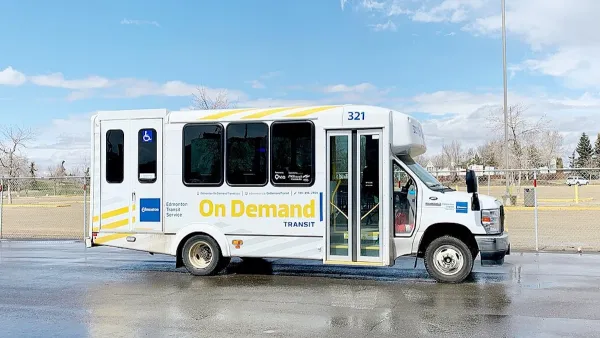Halfway between public transit and private cars, new and varying forms of 'microtransit' threaten to out-compete traditional public services. Concerns about equity, inclusion, and employee compensation follow.

In this piece, Jarrett Walker identifies a potential niche for microtransit, which includes services like UberPool, LyftLine, Bridj, and Leap, among others. What we should avoid, he argues, is a situation where private microtransit companies completely replace public transit.
Instead, "The way forward is for less expensive service tools, including the upstarts, to focus on lower-density suburbia where the land use patterns make efficient big-vehicle transit geometrically impossible. The upstarts could even become contractors of the transit agency part of the time -- paid to do things that they can do more efficiently than big buses can -- as taxis often are today."
If private and public transit cannot find equilibrium, we may face either a cutthroat mobility market or more of the same inefficient public services. "But when I hear the upstarts appealing to elitism, and derogating conventional high-efficiency transit, I wonder where we'll end up ... One thing is for sure: This sector is going to need strong regulation to turn it into a force for good."
Of course, private microtransit has long been a viable mode for city-dwellers in poorer countries. Lacking all start-up flashiness, a multitude of vans and small buses already fills the gaps left by public transit in places like Mexico City and Mumbai.
FULL STORY: Microtransit: good or bad for cities?

National Parks Layoffs Will Cause Communities to Lose Billions
Thousands of essential park workers were laid off this week, just before the busy spring break season.

Retro-silient?: America’s First “Eco-burb,” The Woodlands Turns 50
A master-planned community north of Houston offers lessons on green infrastructure and resilient design, but falls short of its founder’s lofty affordability and walkability goals.

Delivering for America Plan Will Downgrade Mail Service in at Least 49.5 Percent of Zip Codes
Republican and Democrat lawmakers criticize the plan for its disproportionate negative impact on rural communities.

Test News Post 1
This is a summary

Test News Headline 46
Test for the image on the front page.

Balancing Bombs and Butterflies: How the National Guard Protects a Rare Species
The National Guard at Fort Indiantown Gap uses GIS technology and land management strategies to balance military training with conservation efforts, ensuring the survival of the rare eastern regal fritillary butterfly.
Urban Design for Planners 1: Software Tools
This six-course series explores essential urban design concepts using open source software and equips planners with the tools they need to participate fully in the urban design process.
Planning for Universal Design
Learn the tools for implementing Universal Design in planning regulations.
EMC Planning Group, Inc.
Planetizen
Planetizen
Mpact (formerly Rail~Volution)
Great Falls Development Authority, Inc.
HUDs Office of Policy Development and Research
NYU Wagner Graduate School of Public Service





























